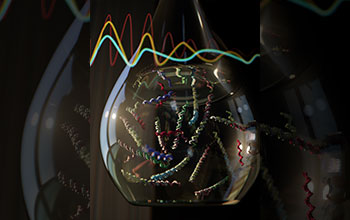Multimedia Gallery
First-of-its-kind chemical oscillator
Image depicting a DNA-only chemical oscillator. Researchers have created the oscillator by building DNA molecules that follow specific instructions. This systematic method has the potential to embed sophisticated circuit computation within molecular systems designed for applications in health care, advanced materials and nanotechnology.
More about this image
DNA molecules that follow specific instructions could offer more precise molecular control of synthetic chemical systems, a discovery that opens the door for engineers to create molecular machines with new and complex behaviors.
A team of researchers at the Cockrell School of Engineering at The University of Texas at Austin has created chemical amplifiers and a chemical oscillator using a systematic method that has the potential to embed sophisticated circuit computation within molecular systems designed for applications in health care, advanced materials and nanotechnology. In their study, the team shows how to program synthetic oscillators and other systems by building DNA molecules that follow specific instructions.
Scientists and engineers have studied chemical oscillators for years. Although understanding of chemical oscillators and other biological chemical processes has evolved significantly, scientists do not know enough to control the chemical activities of living cells. This is leading engineers and scientists to turn to synthetic oscillators that work in test tubes rather than in cells.
David Soloveichik, an assistant professor in the Department of Electrical and Computer Engineering at Cockrell, along with Niranjan Srinivas, a graduate student at the California Institute of Technology, and the study’s co-authors has successfully constructed a first-of-its-kind chemical oscillator that uses DNA components -- and no proteins, enzymes or other cellular components, demonstrating that DNA alone is capable of complex behavior.
According to the researchers, their discovery suggests that DNA can be much more than simply a passive molecule used solely to carry genetic information. "DNA can be used in a much more active manner," Soloveichik said. "We can actually make it dance -- with a rhythm, if you will. This suggests that nucleic acids (DNA and RNA) might be doing more than we thought, which can even inform our understanding of the origin of life, since it is commonly thought that early life was based entirely on RNA."
The team’s new synthetic oscillator could one day be used in synthetic biology or in completely artificial cells, ensuring that certain processes happen in order.
The team’s research was conducted as part of the National Science Foundation’s (NSF) Molecular Programming Project, which launched in 2008 as a faculty collaboration to develop molecular programming into a sophisticated, user-friendly and widely used technology for creating nanoscale devices and systems. [Research supported by NSF grants CCF 0728703, CCF 0829805, CCF 0832824, CCF 1317694, CCF 1117143 and CCF 1618895.]
Read more in the NSF News From the Field story First-of-its-kind chemical oscillator offers new level of molecular control. (Date image taken: November 2017; date originally posted to NSF Multimedia Gallery: March 21, 2018)
Credit: Image courtesy of Ella Maru Studio and Cody Geary
Images and other media in the National Science Foundation Multimedia Gallery are available for use in print and electronic material by NSF employees, members of the media, university staff, teachers and the general public. All media in the gallery are intended for personal, educational and nonprofit/non-commercial use only.
Images credited to the National Science Foundation, a federal agency, are in the public domain. The images were created by employees of the United States Government as part of their official duties or prepared by contractors as "works for hire" for NSF. You may freely use NSF-credited images and, at your discretion, credit NSF with a "Courtesy: National Science Foundation" notation.
Additional information about general usage can be found in Conditions.
Also Available:
Download the high-resolution JPG version of the image. (3.4 MB)
Use your mouse to right-click (Mac users may need to Ctrl-click) the link above and choose the option that will save the file or target to your computer.

